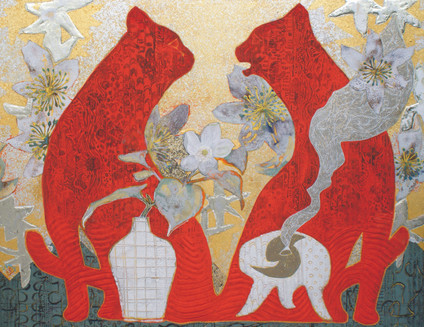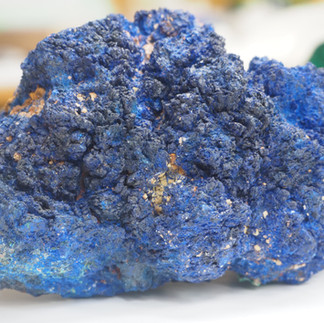Worldview of Japanese Paintings and Yoshihiro Kita’s Visions of Nature
- Mar 9, 2022
- 6 min read
Updated: Apr 30, 2022
Bringing Things Old and Beautiful to the Present


Born in Tokushima Prefecture in 1978, renowned Japanese artist Yoshihiro Kita has breathed a new life into traditional Japanese art, bring-ing it to the modern age. Kita received his PhD in Japanese painting at the Graduate School of Tokyo University of the Arts where his disser-tation titled "The Influence, Resonant, and Incorporation of the Forest" attracted a great deal of attention. While his works are primarily ex-hibited in department stores all around Japan, many of his pieces are being delivered to the homes of art lovers across the country. Kita says that, through the complex texture of his paintings, he aspires to provoke feelings of deep emotion and passion in the viewer, mirroring his thoughts and feelings about the art of Japanese painting.
From Confectionary Shop to Japanese Painter
According to Kita, it was the local confectioners working at his family’s traditional sweets shop in Tokushima who first inspired him to be-come a traditional painter.
"I originally thought that I started painting because I grew up in the artesian environment and culture of a Japanese sweets shop. However, I’ve recently realised that I was, in fact, terrified of confectioners at this early stage in my life. I will never forget the rigorous discipline that the craftsmen showed in their intense gaze while at work."
Kita recalls that, as a child, he used to create figures of anime heroes from the packaging materials he found lying around the store. While known best for his paintings today, during the nine years leading up to his PhD, he rarely painted, preferring to make sculptures and three-dimensional works.
When speaking of his favourite work of art, “The Corridor of Horyuji Temple”, he fondly states: "I feel as if this piece has a strong connection to what I felt during my childhood growing up in a home surrounded by craftsmen. The Horyuji Corridor is quite old and as a result, has a beautiful weathered texture due to ageing. I want to make things that, while old, can still be found quite beautiful."

Intersections Between Japanese Painting and Personal Views of Nature
With a PhD in Japanese painting from the Tokyo University of the Arts, Kita tends to pursue common themes of the beauty of nature as a foundation of his art.
"There are many things that can be seen in life, but I think there are other things that can't be seen. Artists are the ones who make things that are visible, but the beauty of time and memory is invisible. As I strive to pursue ephemeral things within myself, the world view of Japanese painting, which expresses the shade and the sun, the visible and the invisible, where one cannot exist without the other, is my view of nature. I think it fits perfectly," – he says.
The artist is originally from Tokushima Prefecture where in recent years there has been a growing decline in population due to factors such as urban sprawl. To him, the connection between the environment in which one comes from is an important part of the Japanese painting.
"Tokushima is a very nice place, but it's also geographically limited as to what it can offer, since it is situated on a rural island just south-west of the Japanese mainland. I think that many young people these days just want a chance to go across the sea," – he explains. "As a young person, I often felt that this space was small and limiting and that I wished there was something more that I could do to pronounce my expression.
Conveying Emotion through Texture
In the past, Kita had many of hobbies he was passionate about, thus trying to grasp flashes of inspiration in his process of creating art. How-ever, today, he feels he must take a "birds-eye approach" to his works and ask himself about the reasons he is attracted to a particular idea or concept.
"I try not to rely on information technology when creating my work, so that I can make something that is truly interesting." In his creative process, Kita tries to avoid using photographs or sketches, instead focusing on what it was that moved him about the piece and made it fascinating in the first place.
A unique aspect of Japanese paintings is the fact that they can not only be looked at but should be experienced with a sense of touch. It is believed that, in terms of the five senses, the sensation of skin on the material can be just as powerful as seeing it with your eyes. On the other hand, when it comes to the visual perception of a piece, Kita notes that "what you can see from a piece of art is interesting", and explains that there are also invisible elements and textures within the visible aspects of the art. "For example, you can genuinely feel the passage of time from looking at an old wall. That is the "texture" that I wish to convey," – he elabo-rates. By watching and observing, one can feel an intangible sense of the unchanging flow of time. I want to convey these powerful emotions through the "texture" of the piece that connects it all together."
The Artist who smiles at the Goddess of Art
"When I am finally making way on a breakthrough piece, though I cannot show it to people yet, I instinctively want to shout out "I’m a genius!" and pat myself on the back a bit. Something that should take between one and two months will suddenly get done in just one night! I like to describe this stroke of artistic epiphany as "the moment the Goddess of Art cracks a smile"," – he says. "I am very grateful because, without the Goddess of Art, I could never do it on my own", - he adds.
Maybe it is because Kita, who attempts to create art never before seen and so beautiful that a god could dwell within it, that the goddess smiles upon him.
One message in particular that Kita wants to convey through his works is that art can enrich one’s time on Earth. Through this message that is frequently seen in his works, he feels that he contributes to creating a more beautiful existence for his audience.
As Yoshihiro Kita continues his career, he says that he wants to convey beauty not just to Japan, but to the entire world through the texture of his works. He is expected to play an active role in the art world as a remarkable Japanese painter and the whole world will be watching his next move.
All about Traditional Japanese Painting
"Japanese painting is a traditional art form that involves many expensive tools and materials such as natural mineral-based paint, Japanese washi paper, and brushes made from animal hair. The process of traditional Japanese painting is very tedious. As many of the pigments and paints used naturally contain lead, oftentimes materials cannot be easily taken abroad which has made it difficult to showcase as an art form overseas. Despite these challenges, I would like to show Japanese painting to those who have an interest in foreign countries in order to preserve and promote the culture and ways unique to this Japanese art form"
"Even among other Asian art forms, I think that Japanese painting is unique! While the attention tends to be directed solely at the skills and techniques used by the painters, in reality, the painting materials used can be just as interesting given that some of these, such as Japanese washi paper, silk, and brushes, have been passed down from artist to artist for over a thousand years. I am deeply proud to be part of this time-transcending network of artists."
"For creators, these supplies and tools are truly a precious resource, and the older they are, the more often used they are. While traditional tools and materials have much value and beauty, we must also take advantage of what is available to us in the modern age. For example, there are so many unique and magnificent minerals used to make pigments that are rarely found in nature but can give off surreal colours to a cosmic degree. Some of these pigments produce artificial colours using ultraviolet rays and infrared light that exceed even what is the visible range of the human eye. These colours are irreplaceable and provide a certain "colour quality" that can bring comfort in the same way the vibration of an orchestra may."
Pictures/ Yoshihiro Kita 喜多祥泰















